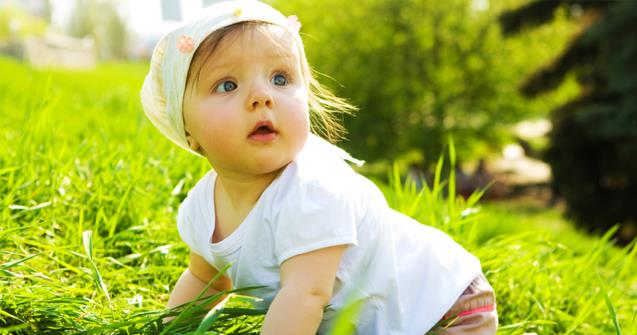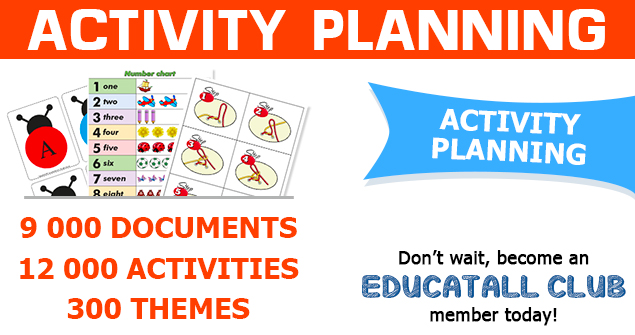
Exploring nature and the outdoors...
Activities for toddlers and babies
Help children develop their sense of touch by discovering nature and the outdoors.
AREA SETUP
Display pictures that represent various textures found in nature (see language activity). Fill a manipulation bin with elements present in nature. Hang a small tree branch horizontally from the ceiling and hang leaves and flowers from it.
ROUTINES AND TRANSITIONS
If you have a garden or fruit-bearing trees, enjoy picking the afternoon snack with your group. They will love exploring the textures. Otherwise, plan a buffet-style picnic including several small food items with different textures. Let children manipulate everything.
SENSORY ACTIVITIES (touch)
Water and textures
Fill a large container or kiddie pool with water. Deposit real leaves and flowers on the water's surface. Little ones will be attracted to these elements. This activity will provide children with the opportunity to explore textures present in nature.
Textured soup
Let children collect items found in nature that they would like to mix with water in a bowl to make a special soup. Encourage them to use their hands to mix the items together. When they are done, provide plastic spatulas and whisks to make the activity last a little longer.
Bare feet
Invite children to remove their shoes so they can explore their environment with their feet. Have them walk on grass, sand, rocks, and leaves. Encourage them to splash in puddles. The only rule that must be respected is to make sure the different surfaces are safe and that no objects with sharp edges are present.
Variation using sand: Prepare a mixture of cornstarch and water and add sand until you have the desired consistency. Deposit the mixture in trays and let children manipulate it. They will find this texture very amusing!
ARTS & CRAFTS
Textured modeling dough
When you are outdoors with your group, collect a variety of different items found in nature. Make your own modeling dough and divide it so that you have several tiny balls of dough. Add a different item (sand, leaves, flower petals, tiny rocks, etc.) to each ball of dough to create textured modeling dough.
Textured modeling dough 2
Use a large rolling pin to roll the modeling dough out on a table. Deposit different items collected in nature on the table and show children how they can press them in the dough to make different prints. The use of leaves, rocks, branches, bark, and pinecones is interesting for this activity.
Leaves from the trees
Collect a variety of leaves from different trees with your group. You can use dry leaves or leaves that have just fallen to the ground. Let babies and toddlers explore the leaves with their hands. They will enjoy tearing them. Encourage them to stick the leaves on a large piece of construction paper or a large piece of adhesive paper.
Colourful branches
To encourage children to explore the texture of tree branches, collect tiny branches and deposit them on a table within your daycare. Show children how they can paint the branches by dipping their fingers in poster paint and then pressing or rubbing them on the branches.
Variation: For little ones, painting leaves or large rocks (supervision required) can also be quite interesting.
MORAL AND SOCIAL ACTIVITIES
Exploring and giving
Flowers are attractive for little ones due to their pretty colors. However, their soft textures are also very interesting for little hands. Collect different types of flowers and encourage babies and toddlers to explore them with their fingers. Allow them to pull the petals off the flowers to make manipulating them easier. Help children prepare a surprise for their mother. Collect wild flowers and arrange them in a bouquet. If you prefer, you can stick petals on a piece of adhesive paper to create little masterpieces.
COGNITIVE ACTIVITIES
Associating textures to animals
Of course, caressing birds is impossible. However, this activity will make it possible for children to associate the soft texture of feathers to the birds they see outdoors. When you see a bird in a tree, present a container filled with feathers. Allow children to manipulate the feathers. If you wish, you could also hide pictures of birds among the feathers.
Variation: If you have fake fur, present this activity to help children associate fur to a squirrel or other animal. Show children how certain animals have feathers while others have fur.
Wet and dry
Elements found in nature that are dry have a different texture when they are wet. Let babies and toddlers manipulate the contents of bins filled with dry elements such as sand, dirt, leaves, and grass. After a while, use watering cans to wet the elements and encourage your little explorers to discover completely different textures. Walking on wet grass is very different from walking on dry grass. Experiment with your group.
PHYSICAL ACTIVITIES AND MOTOR SKILLS
Magnets and textures
This activity will motivate toddlers to walk. Provide large magnets and invite children to search for metallic surfaces their magnet will be attracted to. Explore a variety of surfaces such as stop signs, mailboxes, swings, and slides. Help children discover that magnets are not attracted to certain items such as trees or rocks.
Walking in the rain
When the weather is warm and it is raining lightly, go for a walk in the rain with your group. Encourage children to notice the sensations associated to raindrops falling on their skin. We often forget this simple pleasure.
Nature's little treasures
If you have the opportunity to take your group for a walk on a pedestrian path, you will be able to let toddlers walk safely. You don't have to go very far. Just a few steps will be enough for little ones to make plenty of discoveries. Provide small buckets or containers (egg cartons work well since they can be opened and closed) and let children collect treasures.
LANGUAGE ACTIVITIES
Picture book with textures to discover
Print several close-ups of different textures present in nature: sand, bark, flower petals, rocks, etc. Look at the pictures with your group and name the different elements. Fill a container with the corresponding items and let children manipulate them. If you prefer, go outside and encourage children to find and touch the various items.
Chantal Millette
Early childhood educator
Educatall.com is not responsible for the content of this article. The information mentioned in this article is the responsibility of the author. Educatall.com shall not be held responsible for any litigation or issues resulting from this article.

 Home
Home Theme activities
Theme activities
 Babies and toddlers
Babies and toddlers
 Arts and crafts
Arts and crafts
 Science
Science
 Creative recipes
Creative recipes
 Tips and tricks
Tips and tricks
 Special needs
Special needs
 Extra activities
Extra activities
 Educ-TV
Educ-TV
 Newsletter
Newsletter  Online store
Online store Educatall club
Educatall club


